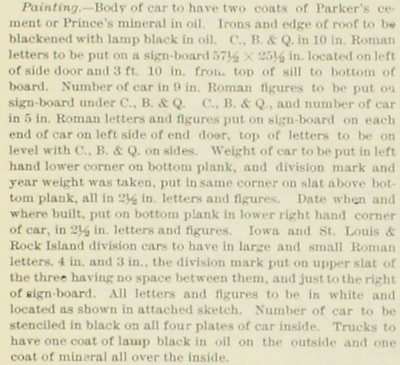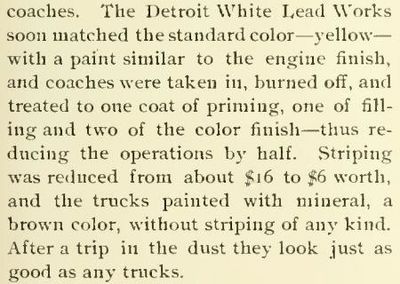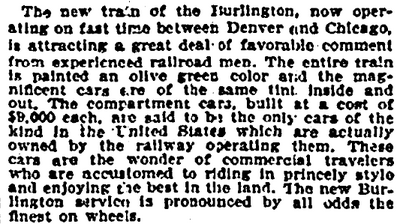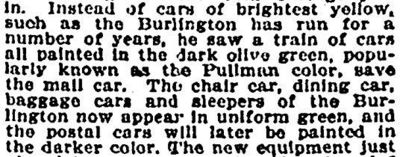Chicago Burlington & Quincy Paint Information
Reference / Historic Railroad Paint Color Index
Locomotives
1887
Baldwin 10-34E locomotives numbered 173 through 191 are delivered in black, no striping, tuscan red roof, yellow lettering, with planished iron boiler jacket.
Baldwin Locomotive Works Engine Specifications vol.14 p.68
1891
Some CB&Q locomotives had stacks painted red, including the entire barrel, operating out of Denver.
Salt Lake Daily Tribune, 30 January 1891
1895
CB&Q paints its boiler jackets; several colors are used, depending on the color of the tender: black and brunswick green are the most common, but tuscan red and olive green are also applied.
"Painting Locomotive Boilers," The Engineer, 6 December 1895 p562.
Freight Cars
1875
Ten CB&Q cars are repainted for the Hoosac Tunnel through line. They are painted “coffee brown” with white lettering.
American Railroad Journal 17 April 1875 p508.
1887
"Old" boxcars operating in 1887 painted slate color.
The Morning News (Savannah, GA), 26 April 1896
Freight car trucks are changed from black to body color.
"It has been the custom for all time to paint the trucks black. This necessitated the changing of pots and brushes when the painting of the body was finished and work commenced on the trucks. The company is commencing now to paint the trucks the same color as the body of the car. This appears to be a small matter, but in the course of a year the time saved in changing, and the cost of extra pots, brushes, etc. dispensed with, amounts to a very considerable little sum."
Railway Review Vol. 27 (1887) p694.
1880
Grain and merchandise cars painted brown, using either Parker's Cement or Prince's Mineral Paint.
The National Car Builder, April 1880, pg. 63
1881
Stock cars painted brown, using either Parker's Cement or Prince's Mineral Paint. Ironwork, trucks and roof edges painted black.
The National Car Builder, September 1881, pg. 109
1883
Boxcars painted brown, using either Parker's Cement or Prince's Mineral Paint. Ironwork, trucks and roof edges painted black.
The National Car Builder, October 1883 pg. 117
1885
"Air Brake" fast freight cars used between Chicago and Denver via the Burlington & Missouri River Railroad had yellow doors, on which were painted a vertical green bar in the center.
"Air Brake" fast freight cars used between Chicago and the Pacific coast via the Atchison Topeka & Santa Fe were painted yellow with black doors On each door was a cross of red and white bars.
The Inter Ocean (Chicago, IL), 7 April 1885
1888
Brown mineral paint begins to be used on ironwork instead of lamp black.
The National Car and Locomotive Builder, October 1888, pg. 151
1893
Prince's Metallic (brown) used on freight cars.
"Chicago, Burlington & Quincy Railroad, Burlington Iowa, June 30th 1893 - GENTLEMEN: I have been using your Metallic Paint on freight cars and buildings for many years, and have found it giving good satisfaction. I recommend it for bridges, and have just started a gang of painters to paint our Iron Bridges with it, of which we have over fifty to be painted this season. Yours Truly, Fred Johnson, Foreman Painter."
The rusting of iron and steel: how it may be prevented and how it is promoted, 1895
Cabooses
1881
Way cars painted orange with English vermillion clerestory, gloss black ironwork, and Tuscan red ladders and doorsteps.
The National Car Builder, September 1881, pg. 102
1892
Cabooses painted yellow.
Heath & Milligan Manufacturing Co. advertisement, The Official Railway List, 1892
1893
Cabooses repainted from yellow to red.
The Aurora Daily Express(Aurora, IL), 21 August 1893
Passenger Equipment
1877
Passenger cars painted orange with red, green and lead striping. Roofs painted sky blue.
The Rock Island Argus (Rock Island, IL), 8 March 1877
1882
Coaches painted canary yellow.
The National Car Builder, August 1882, pg. 86
1888
New passenger cars painted Tuscan red.
The National Car and Locomotive Builder, October 1888, pg. 147
1889
Passenger cars repainted to deep red.
The Saint Paul Daily Globe (St. Paul, MN), 16 March 1889
1892
Headlinings on passenger cars are changed to white with gold striping.
"Work in the C.B.&Q. Shops," Railway Age 9 September 1892 p707.
1893
Some passenger cars still painted yellow.
The Pittsburgh Daily Post (Pittsburgh, PA), 24 February 1893
1895
Coaches painted yellow with mineral brown trucks.
Locomotive Engineering, 1895, pg. 763
1899
Passenger cars used between Denver and Chicago painted olive green.
The Daily News (Denver, CO), 4 May 1899
All CB&Q passenger cars begin to be painted in the “dark olive green, popularly known as the Pullman color, save for the mail car.” CB&Q postal cars “will later be painted in the darker color.”
The Daily News (Denver, CO), 8 May 1899
1904
Passenger cars painted "standard Pullman color" with a broad gold strip along the bottom of the car body, small lettering in gold leaf, and "no fancy gold scoll work."
The Ottumwa Courier (Ottumwa, IA), 27 December 1904
Buildings and Structures
1893
"Permanent buildings" and stations are painted drab.
"Plain buildings," bridges and water tanks are painted with Princes' Metallic (brown).
The rusting of iron and steel: how it may be prevented and how it is promoted, 1895

















